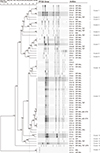Abstract
Background
Campylobacter jejuni is an important food-borne pathogen that causes human gastroenteritis. This study was conducted to investigate the incidence of isolation, antimicrobial susceptibility pattern, and C. jejuni genotype from diarrhea patients in Busan, Korea.
Methods
A total of 97 C. jejuni were isolated from diarrhea patients during five food-borne outbreaks from 2014 to September 2017. Antimicrobial susceptibility tests were carried out by the broth microdilution method for ciprofloxacin (CIP), nalidixic acid (NAL), tetracycline (TET), chloramphenicol, azithromycin (AZI), erythromycin (ERY), streptomycin (STR), gentamicin, and telithromycin. To investigate C. jejuni genotypes, pulsed-field gel electrophoresis (PFGE) profile analysis was performed.
Results
The isolation rate of C. jejuni was 2.0% for the last 4 years and increased annually. Antimicrobial resistance rates of C. jejuni were shown to be in the order of NAL (90.9%), CIP (89.4%), TET (13.6%), AZI (3.0%), ERY (3.0%), and STR (1.5%). The proportion of multidrug-resistance was 18.2%, and they commonly contained quinolones (CIP-NAL). Analysis of PFGE patterns of SmaI-restricted DNA of C. jejuni isolates showed 17 clusters; cluster 11 was the major genotype pattern.
Figures and Tables
Table 2
Antimicrobial resistance rate and minimum inhibitory concentration (MIC) distribution of each agent in 66 C. jejuni

*R: Resistance rate.
Abbreviations: GEN, gentamicin; STR, streptomycin; TEL, telithromycin; AZI, azithromycin; ERY, erythromycin; CIP, ciprofloxacin; NAL, nalidixic acid; CHL, chloramphenicol; TET, tetracycline.
A thick black line indicates the breakpoint and gray shadow area indicates the test range (ug/mL) of each antimicrobial agent.
References
1. Kaakoush NO, Castaño-Rodríguez N, Mitchell HM, Man SM. Global epidemiology of Campylobacter infection. Clin Microbiol Rev. 2015; 28:687–720.
2. Silva J, Leite D, Fernandes M, Mena C, Gibbs PA, Teixeira P. Campylobacter spp. as a foodborne pathogen: a review. Front Microbiol. 2011; 2:200.
3. Allos BM. Campylobacter jejuni infections: update on emerging issues and trends. Clin Infect Dis. 2001; 32:1201–1206.
4. Vanhoof R, Vanderlinden MP, Dierickx R, Lauwers S, Yourassowsky E, Butzler JP. Susceptibility of Campylobacter fetus subsp. jejuni to twenty-nine antimicrobial agents. Antimicrob Agents Chemother. 1978; 14:553–556.
5. Jung SM, Kim NO, Na HY, Hong SH, Chung GT. Prevalence of Campylobacter causing acute diarrhea in Korea, 2012-2015. Pubic Health Wkly Rep. 2016; 9:526–530.
6. Korea Centers for Disease Control and Prevention. Infectious Disease Laboratory Diagnosis; Disease-Specific Protocol. 3rd ed. Seoul: National Institute of Health;2005.
7. Park EH, Kim JA, Choi SH, Bin JH, Cheigh HS, Suk DH, et al. Isolation and antimicrobial susceptibility of Campylobacter jejuni from diarrhea patients. J Life Sci. 2007; 17:811–815.
8. Hur ES, Park PH, Kim JH, Son JS, Yun HJ, Lee YE, et al. Genetic properties and antimicrobial resistance of Campylobacter jejuni isolates from diarrhea patients in Gyeonggi-do. Korean J Microbiol. 2013; 49:228–236.
9. Kim WH, Choi OK, Jeong JA, Park SH, Lee YE, Park GH, et al. Genetic analysis of Campylobacter jejuni isolates from diarrhea patients in Gyeonggi-do. Korean J Microbiol. 2018; 54:31–37.
10. Kim JS, Lee MY, Kim SJ, Jeon SE, Cha I, Hong S, et al. High-level ciprofloxacin-resistant Campylobacter jejuni isolates circulating in humans and animals in Incheon, Republic of Korea. Zoonoses Public Health. 2016; 63:545–554.
11. Wieczorek K, Szewczyk R, Osek J. Prevalence, antimicrobial resistance, and molecular characterization of Campylobacter jejuni and C. coli isolated from retail raw meat in Poland. Vet Med. 2012; 57:293–299.
12. Kim NH, Chae HS, Kang YI, Shin BW, Choi NH, Kim HB. Prevalence and antimicrobial resistance patterns of Campylobacter jejuni from duck feces. Korean J Vet Serv. 2013; 36:57–60.
13. Chae MH, Nam HM, Jang GC, Kim HJ, Kim SR, Jung SC, et al. Antimicrobial resistance in Campylobacter jejuni and Campylobacter coli isolated from food animals and raw meats in slaughterhouse in Korea during 2010. Korean J Vet Public Health. 2013; 35:239–245.
14. Korea Centers for Disease Control & Prevention and Korea National Institute of Health. Korean Antimicrobial Resistance Monitoring System 2014 Annual Report. Osong: KNIH;2016.
15. National Health Insurance Service Ilsan Hospital Institute of Health Insuarance & Clinical Research. last visited on 16 December 2017. https://www.nhimc.or.kr/openInfo/management/audit/hospital_41_disc_audit05_1.do[Online].
16. Nachamkin I, Ung H, Li M. Increasing fluoroquinolone resistance in Campylobacter jejuni, Pennsylvania, USA,1982–2001. Emerg Infect Dis. 2002; 8:1501–1503.
17. Dingle KE, Clarke L, Bowler IC. Ciprofloxacin resistance among human Campylobacter isolates 1991–2004: an update. J Antimicrob Chemother. 2005; 56:435–437.
18. van Hees BC, Veldman-Ariesen MJ, de Jongh BM, Tersmette M, van Pelt W. Regional and seasonal differences in incidence and antibiotic resistance of Campylobacter from a nationwide surveillance study in the Netherlands: an overview of 2000–2004. Clin Microbiol Infect. 2007; 13:305–310.
19. US Food and Drug Administration. NARMS Integrated Report: 2014. The National Antimicrobial Resistance Monitoring System: Enteric Bacteria. Silver Spring: US FDA;2014.
20. Pérez-Boto D, López-Portolés JA, Simón C, Valdezate S, Echeita MA. Study of the molecular mechanisms involved in high-level macrolide resistance of Spanish Campylobacter jejuni and Campylobacter coli strains. J Antimicrob Chemother. 2010; 65:2083–2088.




 PDF
PDF ePub
ePub Citation
Citation Print
Print






 XML Download
XML Download